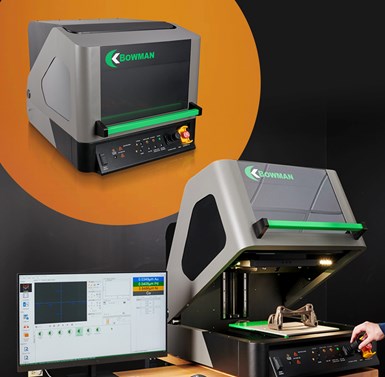XRF Measurement System Fills Need for Multiuse Flexibility, Precision
The K Series is the ninth XRF in Bowman’s benchtop portfolio.

Photo Credit: Bowman
Bowman’s K Series benchtop XRF has an expansive measurement area, selectable spot sizes and high levels of both precision and speed. It has a 12" × 12" measurable area for parts up to 9" tall. Selectable spot sizes accommodate a range of features, including focal distances from .25″ to 3.5″.
The K Series is the ninth XRF in the Bowman benchtop portfolio. Like the other eight systems, K Series instruments simultaneously measure up to 5 layers (base plus 4 plated layers), 10 elements in each layer.
To quantify plated thickness from the detected photons, K Series systems run Bowman’s Archer software. A graphical user interface is said to make the software easy to use, highly intuitive and visually ergonomic. Archer generates customizable Excel reports with no MS Office required, and there is no need to install a software plug-in to export data to customer ERP systems.
The standard K Series configuration includes a 4-position multicollimator. Variable focus simplifies measurements in recessed areas. Programs can use pattern matching and automatic focus for the most precise measurements.
As with all Bowman XRF systems, the K Series features a Silicon Drift Detector (SDD) and long-life, micro-focus X-ray tube. The K Series is well suited for the analysis of metals from aluminum through uranium (13-92 on the periodic table) and for the testing of printed circuit boards, wafers, connectors, electronic components and precious metals on jewelry, upscale hardware and other decorative objects.
The K Series has other features that assist with ease of operation. A cantilever door design gives operators easy access. A servo motor-driven programmable stage streamlines sample positioning. Table-view functionality images the entire measurable area and enables the operator to navigate to any location with a single click.
Related Content
-
Titrations: To Automate or Not to Automate?
What considerations should you keep in mind for automatic titrations? Conor McAnespie of Hanna Instruments discusses the benefits of auto titrators.
-
Shedding Light on Surface Inspection
State-of-the-art reflector-based lighting system improves luminosity and ergonomics for surface inspection tasks while reducing energy usage.
-
NASF/AESF Foundation Research Project #121: Development of a Sustainability Metrics System and a Technical Solution Method for Sustainable Metal Finishing - 14th Quarterly Report
This NASF-AESF Foundation research project report covers the 14th quarter of project work (July-September 2023) at Wayne State University in Detroit.















